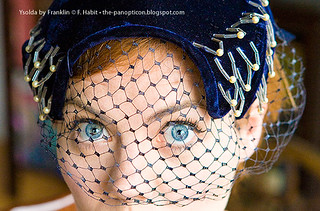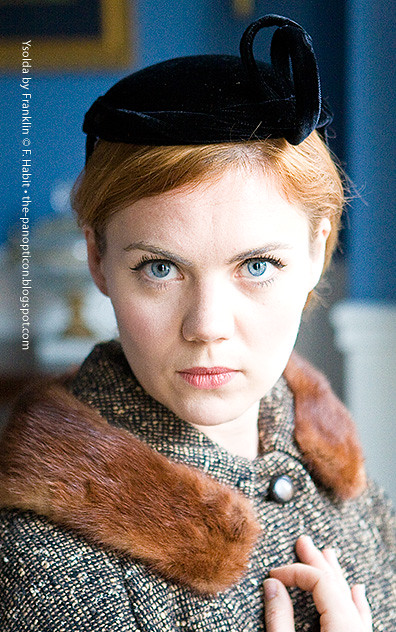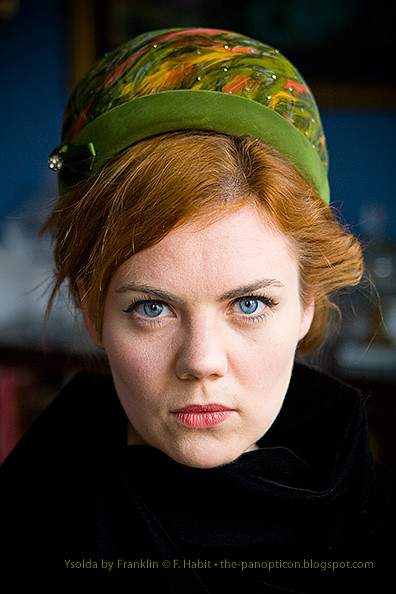I don't know if you'll have missed me, but I sure missed you.
It's been some couple of months, kids. Between work (happily, lots of it) and family tragedy (sadly, lots of it) something had to give; and ultimately the something was the blog.
Dwelling on the past isn't much fun. Dwelling on knitting is. Let us commence to dwell.
During the hiatus I turned out some fun stuff. There was this early twentieth century
Uhlan Cap for the Deep Fall 2012 issue of Knitty.com,

In the same issue, I consulted with Mercedes Tarasovich-Clark on the design of this sweater,
Shoreside,

which was based on the Edwardian
Child's Middy Jumper from the previous issue. (My friend Abigail agreed to serve as an appropriately aristocratic and languid model for the photographs.)
I started writing a monthly column with cartoon for the Lion Brand Yarns newsletter, which has been giddy fun as they let me run amok on the page. You can see the first four installments in the archives
here,
here,
here, and
here.
And there was a whole lot of teaching, which meant time with knitters. Even at my lowest, time with knitters was wonderful. Knitters, they are good people. Knitters know how to comfort and knitters know how to laugh.
There wasn't much time for personal knitting. Just one small piece. A friend of mine–she lives just across the alley–has had a baby. Her first. She is three things–a friend, a good person, and a knitter–which meant she was eligible for a knitted gift. The only question was what to make.
Hat? No. Too simple. This is the woman who showed up, after my grandmother died, with a home-baked pie and a gallon of coordinating artisanal ice cream. She baked me a pie when she was eight months pregnant. She gets more than a hat.
Blanket? No. Not enough time; and even a baby blanket takes up a lot of room while you're working on it. I've spent most of the time since that entry in July away from home, traveling. I needed something portable.
Sweater? Bingo. Interesting, substantial, portable. But designing something was out of the question, so I needed to pick somebody else's pattern.
That's when the postman arrived with a large, heavy packet covered in British stamps and smelling excitingly, even through the wrapper, of old paper. A kind reader in England had decided to send over his collection of vintage British patterns, 1920-1960.
There are times, that being one of them, when the only thing to do is collapse on the settee and marvel at the kindness of relative strangers. The packet's arrival coincided exactly with my grandmother's final trip to the hospital, which was followed by an agony of watching and waiting as she slowly, slowly slipped away. I put the stack of patterns next to the bed and read them at night when I couldn't fall asleep. When I left home, I took a few with me to read on planes and in hotel rooms.
In booklet from Lister & Co. Knitting Wools, Ltd. of Bradford–which had lost its cover but looks to be from the late 40s or early 50s–I found the cardigan I wanted to make. I already had the wool to hand–dear, old St-Denis Nordique–and the classic style was a perfect match for mother's taste.
Here's the finished specimen.
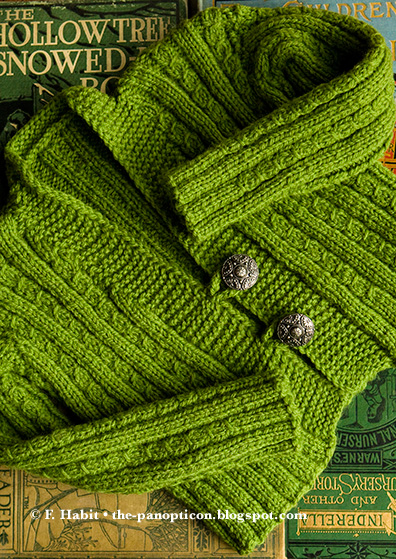
I loved working it. It's flat, in pieces, sewn up–a method I am beginning to appreciate more and more. I'd never entirely give up working in the round, mind you, but there are occasions when seams are the better option. More about that in another entry.
The design had several nice grace notes–indicating a level of attention to detail that's often sadly lacking in modern baby patterns. For example, working the ribbing at the hem and cuffs with a smaller needle. Such a small thing, yet the result is a garment with a better shape and a more elegant finish.
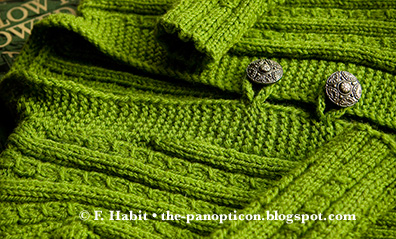
Then there's the main stitch pattern. You think it's cables, right? Looks like little cables.
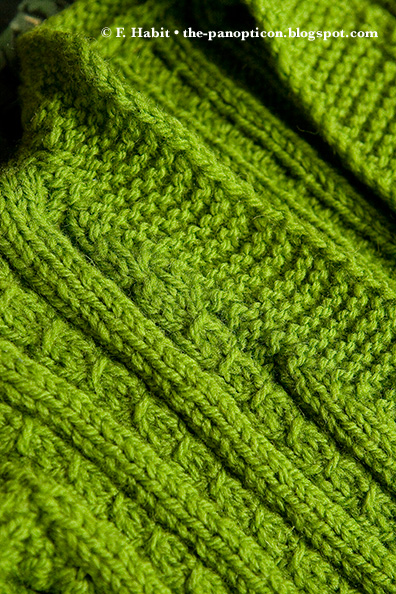
Well, it's not. It's an increase, plus a slipped stitch passed over–listen, if you want, I'll jot down the exact pattern in the next entry–and on the right side it ends up looking cabled. But on the wrong side, just check this out.
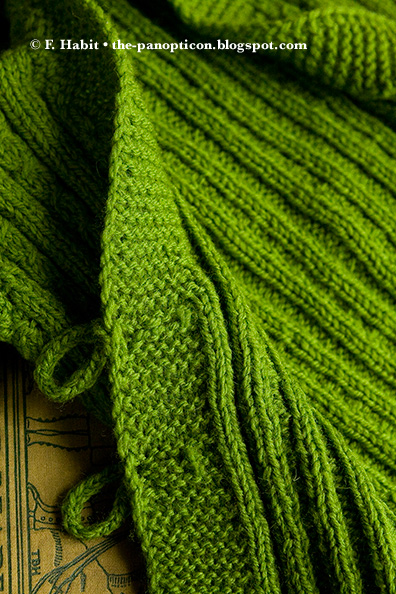
It looks like ribbing. Nice and neat. No weirdness. This stitch pattern is new to me, and I like it very much, and I think it has enormous potential.
On the other hand, there was also the usual rigmarole about button holes on one side for a girl and on the other side for a boy. That drives me batty. I am not a fan of shoving tiny kids into gender-specific clothing in the first place, and why infantine genitalia should have anything to do with buttonhole placement is beyond me.
Ultimately, after giving the pattern's honestly rather dismal two-row buttonholes a fair shake, I ripped back and decided on loops of I-cord.
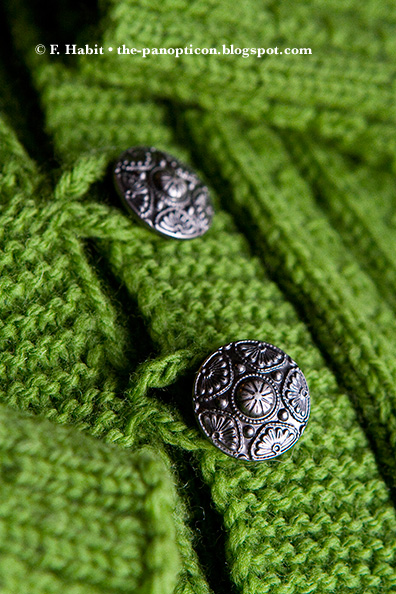
I am painfully enamored with the buttons. Had an interesting time picking them out, though. I went to Vogue Fabrics in Evanston–a wonderful place, and I'm lucky to have it–because of their immense button selection. I was hunting around, finished sweater in hand, when I was accosted by the world's pushiest button salesman. The fellow absolutely would not leave me alone.
"What sort of button do you want?" he asked.
"I'll know it when I see it," I said.
"To go on that sweater?" he asked.
"Yes," I said.
"Oh," he said. "Baby buttons are over here."
He indicated a wall of blue duckies, pink kitties, day-glo plastic daisies. You know, the usual. Fine in the right place, but not on this piece.
"No, thank you," I said. "I don't want baby buttons."
"But it's a baby sweater," he said.
"I know," I said, "but I don't want baby buttons on it."
"But they're real cute," he said.
"But I don't want them," I said.
"What kind of baby sweater has adult buttons on it?"
"This baby sweater will."
"You're not a father, are you?"
"No," I said. "I'm a mother."
Whereupon he disappeared, swiftly, into Ribbons and Trim.
Before I sign off, I have to show you a couple of photographs from the pattern book. I got all kinds of flack once for including a picture of a scowling baby in one of my Knitty columns–as though babies are born with fixed smiles on their faces, and to suggest otherwise is tantamount to child abuse. Seriously, people sent me hate mail for it.
It's true that modern baby models are usually sanitized to the point of inhumanity, but I don't care for the practice and refuse to cater to the Anne Geddes set.
I prefer the
bébé vérité approach of the art department at Lister and Co. Knitting Wools, Ltd.
They showcased old-fashioned English infants who look, as they should have, like little Winston Churchills. The one who modeled the pattern that I knit was obviously having a fit of pique, unimpressed by the fuzzy toy the photographer's assistant was shaking at her.
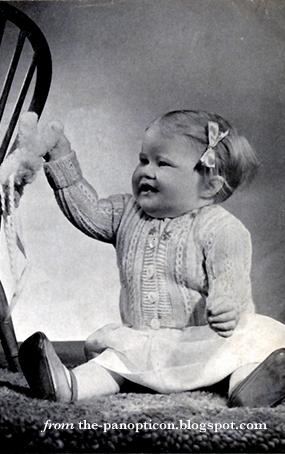
However, there are limits. Had I been the editor, I would have drawn a blue pencil through this page, which includes what I dearly hope was an accidental juxtaposition of photograph and spot illustration (click to embiggen).
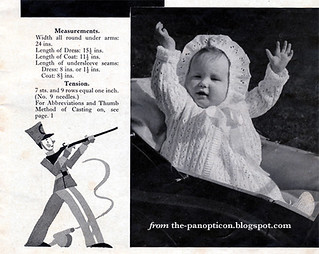
I giggled madly, I admit. But I would
not have wanted to deal with the letters that followed.


